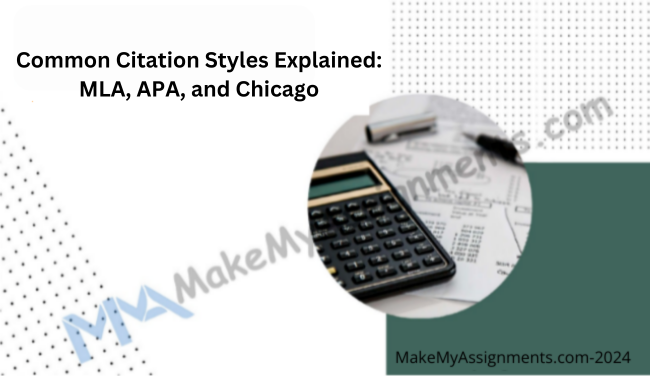
Common Citation Styles Explained: MLA, APA, and Chicago
Citation styles are essential for academic writing, helping students and researchers credit their sources and avoid plagiarism. The three most commonly used styles are MLA, APA, and Chicago. Each style has unique rules and guidelines for formatting, in-text citations, and reference lists. Here’s a quick guide to help you understand these citation styles and when to use each one.
1. MLA (Modern Language Association)
MLA style is widely used in the humanities, especially in subjects like literature, arts, and language studies. It focuses on simplicity and emphasizes the author’s name and page number in in-text citations. Here’s an example of how MLA works:
In-Text Citation Example:
According to Smith, “academic writing requires attention to detail” (45).
Works Cited Page Example:
Smith, John. Writing for Success. New York: Academic Press, 2020.
If you need assignment help for humanities papers, chances are you’ll be required to use MLA. Many students seek homework help or turn to an assignment writer for support, especially when formatting long bibliographies.
2. APA (American Psychological Association)
APA style is commonly used in the social sciences, including psychology, sociology, and education. It prioritizes the publication year, which makes it useful for studies that rely on recent research. APA uses the author’s name and the year of publication in in-text citations, helping readers quickly identify the recency of the sources.
In-Text Citation Example:
Smith (2020) argues that “effective study techniques improve academic performance.”
Reference Page Example:
Smith, J. (2020). Writing for Success. Academic Press.
APA style is often used in research papers that analyze current trends or scientific data. Many students who “make my assignment” or use assignment help services for social science projects are often guided to follow APA formatting.
3. Chicago Style
Chicago style is frequently used in history, arts, and certain humanities subjects. It offers two systems: the Notes and Bibliography system, commonly used in history and humanities, and the Author-Date system, preferred in social sciences. The Notes and Bibliography system relies on footnotes or endnotes rather than in-text citations, which some students find helpful when they need homework help with detailed or complex projects.
Footnote Example (Notes and Bibliography):
1. John Smith, Writing for Success (New York: Academic Press, 2020), 45.
Bibliography Example:
Smith, John. Writing for Success. New York: Academic Press, 2020.
This style is more flexible, allowing for a wider range of source types, from websites and books to manuscripts and speeches. If you’re unsure about how to use Chicago style or if your assignment calls for an unusual source, consulting an assignment writer or using assignment help services can save you time.
When to Use Each Style
Understanding which citation style to use depends on your field of study and your professor’s preferences. Here’s a quick guide:
- MLA – Best for humanities and arts subjects (literature, language studies).
- APA – Ideal for social sciences (psychology, sociology, education).
- Chicago – Common in history and certain humanities, as well as arts.
Tips for Mastering Citation Styles
- Use Citation Tools – Tools like Zotero, EndNote, or even Microsoft Word’s built-in citation manager can simplify citation formatting.
- Check Assignment Guidelines – Always verify with your professor which style is required before you begin. Different assignments may call for different citation formats.
- Seek Assignment Help – Many assignment help services offer citation and formatting assistance. A knowledgeable assignment writer can help ensure your citations meet academic standards.
Understanding MLA, APA, and Chicago citation styles doesn’t have to be overwhelming. By learning the basics of each, you’ll be prepared to tackle assignments in different subjects. And remember, if you need a hand, assignment help and homework help services are there to support you through the formatting process, ensuring your work is both credible and polished.






